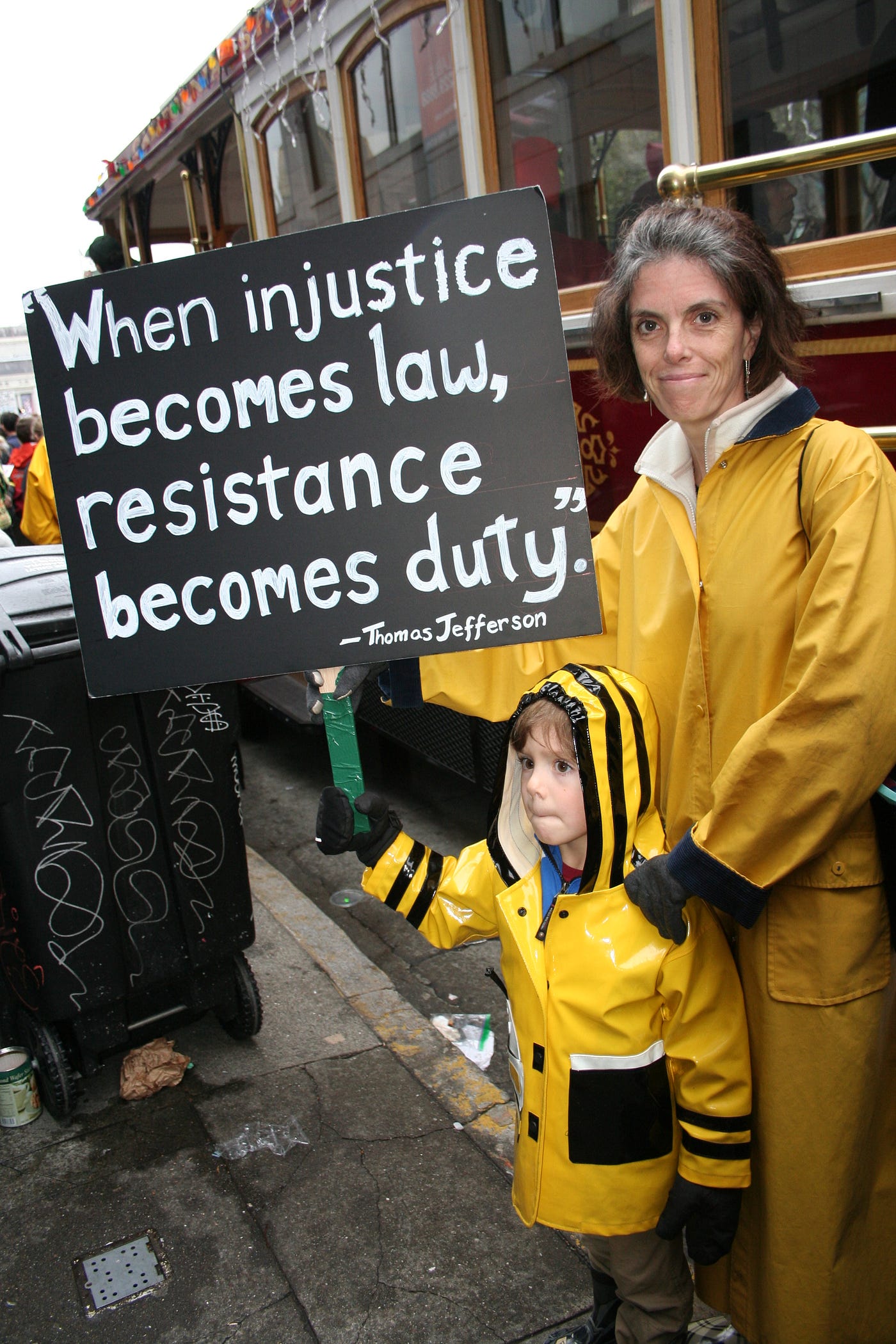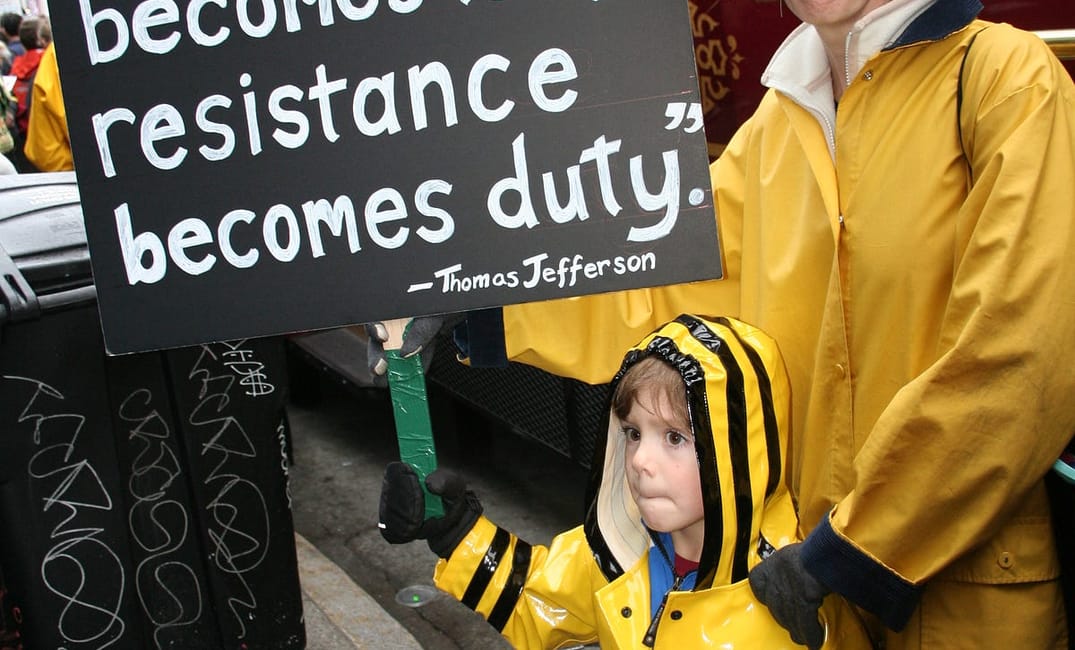
Civil-resistance expert Erica Chenoweth, PhD, recently released an encouraging statistic: Since the year 1900, every resistance campaign with at least 3.5 percent of its country’s population actively involved has succeeded in overthrowing a sitting government.
If we apply this rule to the US, it would only take 11 million people to oust the Trump administration.
When I first read that number, I didn’t believe it. It sounds like 3.5 percent would be a fraction of what would be necessary to overthrow a government. But I looked into Chenoweth’s research, outlined in her book Why Civil Resistance Works, and learned that resistance movements in Serbia, Mongolia and the Philippines succeeded with just that 3.5 percent. If we apply this rule to the US, it would only take 11 million people to oust the Trump administration.
Chenoweth gives multiple definitions for “active resistance,” including marching in the streets, strikes and synchronized shutdowns in which whole cities turn off their power. It could also include pressuring elected officials, funding organizations that are resisting a given regime and even running for office. In all instances, “active resistance” means a public demonstration of dissent.
This tactic could be a game changer for resisting the Trump administration moving forward. Rather than attempting to turn Trump supporters into Trump resisters, we could rally passive Trump resisters into active Trump resisters. As the president’s approval rating continues to drop to historic lows, new Trump resisters are coming out of the woodwork every day. The question becomes, how do we move from passive disapproval to active resistance? Blue Heart, an organization that specializes in civilian activation, gave me some advice.

Five Easy Steps for Activating a Trump Resister (and Possibly Yourself!)
1. Practice Assigning Your Name
Blue Heart cofounder Theo Gibbs explained the importance of getting a resister to attach their name to a given issue. “Signing a petition is a relatively small thing, but it does mean a certain level of social accountability and a reinforcement of identity. It’s a small way of reminding yourself, ‘I am someone who actively cares about issue X.’”
When asked if a vote against Trump counted as an act of active resistance, Gibbs said no. “A vote made by secret ballot doesn’t require social accountability on behalf of the voter, nor does an opinion poll. But a public petition is a different story.”
So if you’re ready to begin actively resisting the Trump administration, start by signing a petition. Change.org features multiple Trump-related petitions, from those calling for his impeachment to those calling for the resignation of his cabinet members.
2. Make It Public
This may seem like a no-brainer to some, but a political Facebook post or tweet can be a big step. And the deeper a new resister goes into their reasoning in a social media post, the better. “Don’t just share what you care about,” Gibbs said. “Share why you care about it in your own words.”
Facebook is a good place to start because it provides space for long-form posts, giving the resister the opportunity to solidify their ideas by explaining — even defending — their cause to their friends. It can also create what Gibbs termed a “reward loop,” in which the poster receives likes and comments, a valuable step in habit formation.
“Once you’ve started a dialogue, you can ask your friends to consider joining you in signing the petition or supporting the issue.”
3. Recognize Your Comfort Zone and Practice Moving beyond It
For the record, though, this step does not mean “get yourself arrested” (unless that’s your cup of tea). It means recognizing what works for you and strategizing about broadening your scope.

You’ve already signed a petition and posted on social media, but what about attending a march? New to protesting? Why not start with a well-organized daytime march? How would you feel about a strike? If you’re unable to strike, consider hosting an event or a discussion group within your community. Organizations like the Women’s March and SURJ make it easy.
There is always a way to up your resistance efforts. According to Blue Heart cofounder Lindley Mease, the actions that work best to activate resisters are ones rooted in issues resisters care about, particularly those that affect them directly. “A number of organizations provide bite-size political actions (e.g., My Civic Workout), and though these work for some people, we’ve observed that others lose interest quickly. They get overwhelmed by the plethora of issues and calls to action, or they feel uncertain about whether those actions really make a difference. In order to effectively sustain and grow social movements, we need to engage the heart and the senses — not just the intellect and pocketbooks. Building a personal resistance strategy means knowing what really moves you.”
4. Educate Yourself
Now that you’ve made your own beliefs public, take some time to see what other people think. In addition to Erica Chenoweth’s Why Civil Resistance Works, Howard Zinn’s A People’s History of the United States and Mark and Paul Engler’s This Is an Uprising are great places to start when investigating the way civil resistance continues to grow.
But as Lindley Mease cautions, staying motivated can mean more just than reading. “You aren’t going to become an ‘ally’ just by going to 10 reading groups,” Mease said. “People aren’t motivated by facts in isolation; they’re motivated by relationships and empathy. Experiential education is vital for engagement. Everyone’s talking about the importance of Democrats meeting Trump supporters and bridging the partisan divide. Of course, that’s important, but perhaps it’s even more important for liberals to meet those most affected by systemic injustice and understand how to give direct support to the communities their ‘liberal’ policies are purportedly defending.”
5. Interact Directly with Affected Communities
Meet the people you’re trying to help. This can be quite difficult — even uncomfortable — for a lot of new resisters. As Theo Gibbs explains, “Through seeking interaction and relationships with people who are being directly impacted by Trump’s policies, we strengthen our muscles of empathy and create a foundation for sustained action.”
You may think Trump’s attempted bans on Muslim immigration are unconscionable, but have you met a Muslim immigrant? You won’t stand for ICE raids on unsuspecting families, but do you know anyone in danger of deportation? You support the Black Lives Matter movement, but have you met a victim of police violence?
We’re living in an oddly unifying political moment, and it’s the lives affected by these issues that keep Trump resisters active. “A basic and powerful truth of being human is that it’s harder to ignore an issue if you personally know someone affected by it,” Gibbs went on to say. “We tend to take action on the issues that personally affect us or people we know and care about, but it also means that we don’t usually take action on issues that feel ‘faraway’ from our lived experience.”
Don’t ever forget: an active response of 3.5 percent is possible, and in fact, we’re already close! Between four and five million people marched in the US for the Women’s March on January 21. That’s almost half the people necessary to reach the critical mass of 11 million, and that was one day into Trump’s presidency! Get out there.







